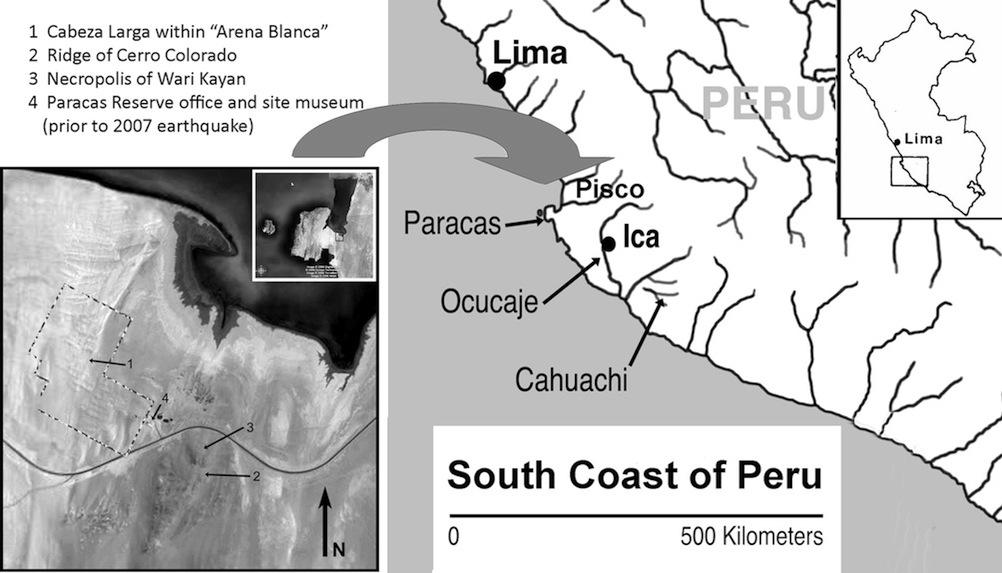
The Paracas Site lies on the summit and northern side of Cerro Colorado, facing the Bay of Paracas and Pacific Ocean, on a neck of land that joins the Paracas Peninsula to the desert plains, irrigated valleys, and slopes of the western watersheds of the Central Andean cordillera. Paracas research has been dominated by studies of the elaborately embroidered garments from layered mortuary bundles built around the bodies of the dead in the Necropolis of Wari Kayan, excavated in 1927-8 by Peruvian archaeologist Julio C. Tello. While small groups of textile-wrapped burials were recovered from all sectors of the Paracas site, the ‘Necropolis’ refers to a two densely concentrated burial clusters on the north slope of Cerro Colorado.
When excavating the cemetery, Tello and his collaborators observed tightly wrapped bundles, stitched and bound into a conical form, with cloth-wrapped baskets and ceramics, foodstuffs, feather- or cotton-tasseled ‘signal’ canes and weapons placed along the northern base at their ‘feet’. The largest bundles were placed in deep pits filled with clean sand, and smaller bundles have been set into the hillside both prior to these and on top of them, surrounded by more variable fill (Tello et al. 2012).
All these pit tombs had been cut into layers of refuse and old floors, among and within the walls built by an earlier people. These buildings were associated with incised ceramics that often retained the bright colors of resin paint, applied after firing when the clay was still hot (Menzel, Rowe and Dawson 1964). Among the hollows along the ridge of Cerro Colorado, shaft tombs contained burials associated with these Paracas Tradition ceramics. In contrast, the intrusive pit tombs of the Necropolis were associated with fine, modeled ceramics painted with cream and red slips, including black-interior bowls with pattern-burnished designs: distinctive production practices later named the Topará Tradition (Lanning 1960, Wallace 1986). Tello identified two occupation phases, associated with different mortuary patterns as well as different ceramics: ‘Paracas Cavernas’ (the shaft tombs) and ‘Paracas Necropolis’.
While Tello and members of his research team published descriptions of the structure and sequence of several mortuary bundles and examples of many artifact types (Tello 1929, 1959; Yacovleff and Muelle 1934; Carrión 1949; Tello and Mejía 1979), subsequent analysis of Paracas Necropolis mortuary assemblages (Paul 1990, 1991) and artifacts from the cemetery have largely focused on the colorful and complex embroidered garments and headdress elements. Most studies illustrate objects from a small group of the most complex burials, whose elaborate curvilinear ‘Block Color’ style images resemble those painted on early Nasca ceramics (see Bibliography in PDF). J. Dwyer (1979) studied the textile styles in detail, proposing that the earlier Necropolis burials were contemporary with late phases of the Paracas tradition, while later burials were contemporary with early phases of the Nasca tradition.
Our observations support this chronology, but we also observe evidence for the genesis of the Nasca style among the earliest burials, and textiles emblematic of a Paracas tradition identity placed in the latest burials. Our evidence indicates that three ‘material culture traditions’ that archaeologists term late Paracas, Topará and early Nasca coexisted during the creation of this cemetery. In our model of the social history of this region circa 250 BC to AD 150, many kinship-based communities affiliated with these traditions produced fine textiles and other artifacts in their own local styles, engaging each other in combat, political alliance and many kinds of exchange relationships (Peters 2008, 2012). Mortuary rites at the neck of the Paracas Peninsula probably brought people together from different communities to compete in offering elaborate textiles in honor of their prominent ancestors.
About this project
The information presented here is the product of years of research by archaeologists, bio-anthropologists and art historians in Peru, the United States and Europe. Here it is brought together in digital form, as part of the project Practice in Life, Presence after Death: Style and Substance at the Paracas Necropolis, supported by grant No. 0852151 of The National Science Foundation. The project continues, and we invite our colleagues to contribute new and expanded information to the database as we each develop and publish our research. We would like to add your publications to our Paracas bibliography. This collaborative effort honors the initiative, high standards, and dedication of Dr. Julio Cesar Tello and the research team he built in the early 20th century, at the dawn of professional archaeology. Dr. Tello forged international alliances in order to develop research projects and Peruvian institutions, sharing his vision, methods and vast accumulation of archaeological data with both students and colleagues.
